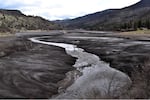
The Klamath River carving through the bed of the former Copco Lake reservoir.
Juliet Grable / JPR
The Siskiyou County Board of Supervisors proclaimed a local emergency Tuesday and requested that the governor proclaim a state of emergency based on water quality concerns in the Klamath River as four dams are being removed.
The goal of removing the dams on the Oregon-California border is to improve the river ecosystem and the health of salmon populations.
Some residents are worried because a round of water testing commissioned by the county earlier this year showed elevated levels of naturally-occurring heavy metals like arsenic and lead.
Many residents spoke during public comment periods during the nearly six-hour meeting, expressing concerns about fish killed as the reservoirs were drained, deer trapped in mudflats and potential human health issues.
But Matt St. John, with California’s North Coast Regional Water Quality Control Board, said they expected the water to have high levels of these chemicals when it was tested because they knew that sediment containing these metals had accumulated behind the dams.
“However, these short-term impacts are anticipated to diminish over time as sediments are either flushed down the Klamath River or stabilized in place and a more naturally-functioning river system takes hold,” he said.
Still, the board voted 4-1 to approve the local emergency. Supervisor Ed Valenzuela voted against it. The proclamation includes a request that the governor issue a state of emergency and make any necessary funding available for recovery.
St. John said the water does not pose any public health risk, even recreationally.
“We understand that there are concerns regarding the heavy metals [in] samples that were collected by the county. But it’s important to keep in mind that the water quality conditions recorded by the county’s one round of monitoring provides a snapshot of water quality from late January, which was the period that was expected to have the highest levels of suspended sediment and associated inorganic chemicals including metals. And that snapshot of water quality may not represent the current water quality condition now at the end of March,” he said.
The Klamath River is currently not the source of drinking water for any communities in order to mitigate concerns about unsafe drinking water.
Mark Bransom, CEO of the Klamath River Renewal Corporation, the nonprofit in charge of the project, said removing the dams will have multiple long-term benefits.
“Why are these dams being removed? Well, they created water quality problems, which we’re trying to address,” he said.
According to the California State Water Resources Control Board, the metals in the sediment are not expected to leach into groundwater wells, Bransom said.
He said during the meeting that KRRC will conduct another round of water testing.
The emergency declaration must be brought back before the board at least once every 60 days in order to stay active.